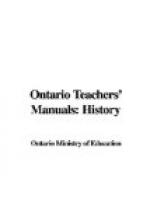(Given to the class by the teacher’s oral explanation)
1. The Saxon System: Further study of the early land tenure of the Saxons. (See Ontario High School History of England, p. 33.) The following extract from Oman’s England before the Norman Conquest may be of assistance:
The typical free settlement of an English maegth (or kindred) consisted first of the large arable fields divided up into narrow strips, of which each household possessed several, next of the almost equally prized meadow, which was hedged off into appropriated lots in summer, but thrown back into common in winter, and lastly of the undistributed waste, from which the whole community would draw its wood supply, and on which it would pasture its swine, or even turn out its cattle for rough grazing at some seasons.
The normal method of agriculture was the “three-field system,” with a rotation of wheat, barley, or oats, and in the third year, fallow—to allow of the exhausted soil regaining some measure of its fertility. In the last year the field was left unfenced and the cattle of the community picked up what they could from it, when they were neither on the waste, nor being fed with the hay that had been mowed from the meadow. There seem to have been exceptional cases in which the strips of the arable were not permanently allotted to different households, but were distributed, by lot or otherwise, to different holders in different years. But this was an abnormal arrangement; usually the proprietorship of the strips in each field was fixed. And the usual arrangement would be that the fully endowed ceorl’s household had just so much arable in its various strips as a full team of oxen could plough.
Then explain the origin of the names “Eorl” and “Thegn” (P.S. Hist. of Eng., pp. 34 and 37); the idea of protection (P.S. Hist. of Eng., p. 37), and of sharing in the produce of the land, and the payment of necessary fees to the King. Emphasize the ownership of the land by the freeman.
2. The Courts: The Witan, which could displace the king for certain reasons, the Shire or folk-moot, and the Tun-moot; their powers; the people looked to these courts for justice.
3. Change brought about by Danish raids—small freeholders sought protection from the greater lords; the shifting of ownership from small landowners to “eorls.”
STEP III
The Feudal System in France: (Read Scott’s Quentin Durward.) Barons too powerful for the king for various reasons:
1. Their property was large and compact.
2. They administered justice, issued coinage, etc.
3. Vassals swore allegiance to their immediate superior.
By means of problem-questions develop from the pupils what William would probably do to strengthen his own position.




